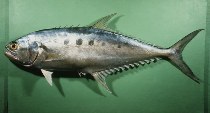| Family: |
Carangidae (Jacks and pompanos), subfamily: Scomberoidinae |
| Max. size: |
120 cm TL (male/unsexed); max.weight: 16 kg |
| Environment: |
reef-associated; brackish; marine; depth range - 50 m, amphidromous |
| Distribution: |
Indo-West Pacific. |
| Diagnosis: |
Dorsal spines (total): 7-8; Dorsal soft rays (total): 19-21; Anal spines: 3-3; Anal soft rays: 16-19. Description: Dusky green to bluish dorsally, shading to silvery or gray (golden in some large adults) with 5-8 large greyish blotches above LL, first two may intersect LL; dorsal lobe dusky to dark and evenly pigmented. Body oblong and elliptical, strongly compressed; dorsal and ventral profiles about equal; upper jaw extending well beyond posterior edge of eye in adult; scales partly embedded, midbody breast scales below LL oval or broadly oblong, other scales small and lanceolate (Ref. 2334, 90102). Soft dorsal and anal fins with semi-detached finlets (Ref. 2334). |
| Biology: |
Adults inhabit coastal waters, frequently near reefs and offshore islands (Ref. 30573, 48635). Occasionally found in estuaries. Usually in small groups (Ref. 9710, 48635). Feed on fishes, cephalopods, small invertebrates and, other pelagic prey (Ref. 5213, 90102). |
| IUCN Red List Status: |
Least Concern (LC); Date assessed: 10 March 2015 Ref. (130435)
|
| Threat to humans: |
harmless |
Source and more info: www.fishbase.org. For personal, classroom, and other internal use only. Not for publication.
